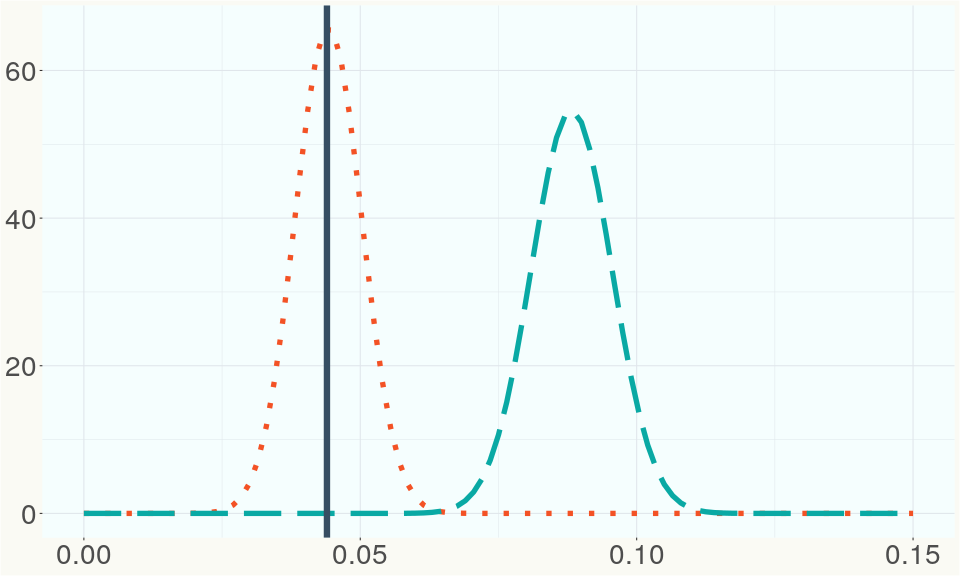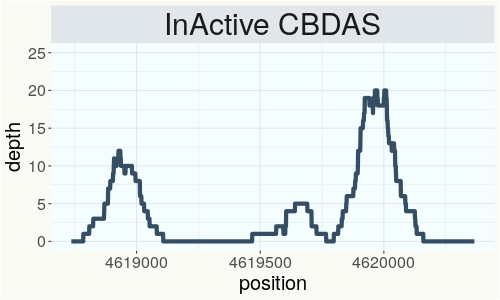Durban Poison
RSP 11014
Grower: DigiPath Labs
General Information
- Sample Name
- F20170411-04-1
- Accession Date
- September 17, 2017
- Reported Plant Sex
- Female
- Report Type
- StrainSEEK v2 3.2Mb
- DNA Extracted From
- Unknown
The strain rarity visualization shows how distant the strain is from the other cultivars in the Kannapedia database. The y-axis represents genetic distance, getting farther as you go up. The width of the visualization at any position along the y-axis shows how many strains there are in the database at that genetic distance. So, a common strain will have a more bottom-heavy shape, while uncommon and rare cultivars will have a visualization that is generally shifted towards the top.
Chemical Information
Cannabinoid and terpenoid information provided by the grower.
Cannabinoids
- THC + THCA
- 25.7%
- CBD + CBDA
- 0.052%
- THCV + THCVA
- 0.%
- CBC + CBCA
- 0.046%
- CBG + CBGA
- 0.766%
- CBN + CBNA
- 0.355%
Terpenoids
- α-Bisabolol
- 0.026%
- Borneol
- n/a
- Camphene
- 0.014%
- Carene
- 0.214%
- Caryophyllene oxide
- 0.015%
- β-Caryophyllene
- 0.337%
- Fenchol
- n/a
- Geraniol
- 0.014%
- α-Humulene
- 0.147%
- Limonene
- 0.656%
- Linalool
- 0.022%
- Myrcene
- 2.163%
- α-Phellandrene
- n/a
- Terpinolene
- 6.619%
- α-Terpineol
- n/a
- α-Terpinene
- 0.297%
- γ-Terpinene
- 5.543%
- Total Nerolidol
- 0.044%
- Total Ocimene
- 2.885%
- α-Pinene
- 0.485%
- β-Pinene
- 1.065%
Genetic Information
- Plant Type
- Type I
File Downloads
The bell curve in the heterozygosity visualization shows the distribution of heterozygosity levels for cannabis cultivars in the Kannapedia database. The green line shows where this particular strain fits within the distribution. Heterozygosity is associated with heterosis (aka hybrid vigor) but also leads to the production of more variable offspring. When plants have two genetically different parents, heterozygosity levels will be higher than if it has been inbred or backcrossed repeatedly.
The ratio of reads mapped to Y-contigs to reads mapped to the whole Cannabis genome (Y-ratios) has been demonstrated to be strongly correlated with plant sex typing. This plot shows the distribution of Y-ratios for all samples in our database which were sequenced with the same method (panel or WGS) as this sample and where this sample falls in the distribution.

This chart represents the Illumina sequence coverage over the Bt/Bd allele. These are the three regions in the cannabis genome that impact THCA, CBDA, CBGA production. Coverage over the Active CBDAS gene is highly correlated with Type II and Type III plants as described by Etienne de Meijer. Coverage over the THCA gene is highly correlated with Type I and Type II plants but is anti-correlated with Type III plants. Type I plants require coverage over the inactive CBDA loci and no coverage over the Active CBDA gene. Lack of coverage over the Active CBDA and Active THCA allele are presumed to be Type IV plants (CBGA dominant). While deletions of entire THCAS and CBDAS genes are the most common Bt:Bd alleles observed, it is possible to have plants with these genes where functional expression of the enzyme is disrupted by deactivating point mutations (Kojoma et al. 2006).



This chart represents the Illumina sequence coverage over the CBCA synthase gene.

Variants (THCAS, CBDAS, and CBCAS)
No variants to report
Variants (Select Genes of Interest)
| PKSG-2a | c.67T>A | p.Phe23Ile | missense variant | moderate | contig700 | 1945567 | A/T | |
| PKSG-2a | c.31A>T | p.Thr11Ser | missense variant | moderate | contig700 | 1945603 | T/A | |
| PKSG-2b | c.1152T>A | p.Asn384Lys | missense variant | moderate | contig700 | 1950486 | A/T | |
| PKSG-2b | c.1132C>G | p.Leu378Val | missense variant | moderate | contig700 | 1950506 | G/C |
|
| PKSG-2b | c.1117A>G | p.Ile373Val | missense variant | moderate | contig700 | 1950521 | T/C | |
| PKSG-4b | c.496A>G | p.Lys166Glu | missense variant | moderate | contig700 | 2721177 | T/C | |
| PKSG-4b | c.489delT | p.Phe163fs | frameshift variant | high | contig700 | 2721183 | CA/C | |
| PKSG-4b | c.485A>G | p.Lys162Arg | missense variant | moderate | contig700 | 2721188 | T/C | |
| aPT1 | c.406A>G | p.Ile136Val | missense variant | moderate | contig121 | 2839605 | A/G |
Nearest genetic relatives (All Samples)
- 0.006 Durban Poison (RSP11226)
- 0.007 Durban Poison (RSP10998)
- 0.008 Durban Poison #1 (RSP11013)
- 0.011 Durban Poison #1 (RSP10996)
- 0.139 Black Jack (RSP10603)
- 0.142 Domnesia (RSP11184)
- 0.150 RKM-2018-025 (RSP11117)
- 0.151 RKM-2018-016 (RSP11108)
- 0.155 Lift (RSP11378)
- 0.156 BLACK JACK (RSP11346)
- 0.164 UnObtanium (RSP11611)
- 0.169 Gold Cracker (RSP11048)
- 0.171 Electra (RSP11366)
- 0.173 Doug s Varin (RSP11243)
- 0.175 Serious Happiness (RSP10763)
- 0.182 Gold Cracker (RSP11041)
- 0.184 Saint Jack (RSP11179)
- 0.185 Trump x Trump (RSP11466)
- 0.187 RKM-2018-027 (RSP11119)
- 0.188 Blue Dream (RSP11004)
Most genetically distant strains (All Samples)
- 0.419 Cherry Blossom (RSP11323)
- 0.418 80E (RSP11213)
- 0.408 80E (RSP11211)
- 0.399 80E (RSP11212)
- 0.396 CS (RSP11208)
- 0.392 Cherry Blossom (RSP11314)
- 0.389 Feral (RSP11205)
- 0.383 Feral (RSP11206)
- 0.382 Cherry Blossom (RSP11318)
- 0.379 R1in136 (SRR14708227)
- 0.378 R1in136 (SRR14708226)
- 0.377 Cherry Blossom (RSP11328)
- 0.377 Feral (RSP10891)
- 0.377 Feral (RSP10890)
- 0.375 Cherry Blossom (RSP11317)
- 0.374 Cherry Blossom (RSP11333)
- 0.370 Cherry Blossom (RSP11306)
- 0.368 IUP2 (SRR14708257)
- 0.368 XBL1 (SRR14708207)
- 0.367 Cherry Blossom (RSP11311)
Nearest genetic relative in Phylos dataset
- Overlapping SNPs:
- 77
- Concordance:
- 76
Nearest genetic relative in Lynch dataset
- Overlapping SNPs:
- 10
- Concordance:
- 10
Blockchain Registration Information
- Transaction ID
-
d6e4fab293bf94f9
23a0f6cac001ab7b 1ced8f01640f2013 9ed20b6054d384f8 - Stamping Certificate
- Download PDF (854.2 KB)
- SHASUM Hash
-
5b0f2a198fc77e26575b920b08826556 7e85e94048617010 b1b5f7d301e23e00